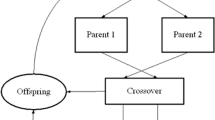Abstract
Reasonable and scientific prediction for railway freight volume has an important impact on railway network planning and railway transportation resources allocation. However, to predict the future railway freight volume is complicated and difficult, because it is influenced by many factors, such as macro economy, industrial structure, and supply capacity, etc. In this paper, an improved prediction model is proposed, named as GCA-GA-GNN. GCA is short for grey correlation analysis, which was adopted to select the key factors which have great influence on railway freight volume instead of subjective factors. GNN is the main body of the prediction model, which combines grey prediction model and neural networks to take the advantages of linear and nonlinear modeling capabilities. Moreover, genetic algorithm is used in GNN to improve calculating speed. Then, the validity of the model was verified by the empirical case of China. The results of five different prediction models showed that the model proposed in this paper has faster convergence speed and higher prediction accuracy. Moreover, according to the downward trend of China railway freight volume from the year 2017 to 2020, some suggestions are proposed to reverse the downward trend and increase railway corporation’s profits.







Similar content being viewed by others
References
Yang, Y.D.: Development of the regional freight transportation demand prediction models based on the regression analysis methods. Neurocomputing 158, 42–47 (2015)
Zhao, J.Y., Zhou, S.F., Cui, X.J., Wang, G.Q.: Predictive method of highway freight volume based on fuzzy linear regression model. J. Traff. Transp. Eng. 12(3), 80–85 (2012)
Xue, R., Sun, J., Chen, S.K.: Short-term bus passenger demand prediction based on time series model and interactive multiple model approach. Discrete Dynam. Nat. Soc. 2015(682390), 11 (2015)
Garrido, R.A., Mahmassani, H.S.: Forecasting freight transportation demand with the space-time multinomial probit model. Transp. Res. B 34(5), 403–418 (2000)
Zeng, B., Meng, W., Liu, S.F.: Research on prediction model of oscillatory sequence based on GM (1,1) and its application in electricity demand prediction. J. Grey Syst. 25(4), 31–40 (2013)
Valente, G.F.S., Mendonca, R.C.S., Pereira, J.A.M.: Artificial neural network prediction of chemical oxygen demand in dairy industry effluent treated by electrocoagulation. Sep. Purif. Technol. 132, 627–633 (2014)
Behboudian, S., Tabesh, M., Falahnezhad, M., Ghavanini, F.A.: A long-term prediction of domestic water demand using preprocessing in artificial neural network. J. Water Supply Res. Technol. AQUA 63, 31–42 (2014)
Babel, M.S., Shinde, V.R.: Identifying prominent explanatory variables for water demand prediction using artificial neural networks: a case study of Bangkok. Water Res. Manag. 25(6), 1653–1676 (2011)
Sun, Y., Lang, M.X., Wang, D.Z., Liu, L.Y.: Prediction models for railway freight volume based on artificial neural networks. Appl. Mech. Mater. 2014, 2093–2098 (2014)
Guo, Y.H., Chen, Z.Y., Feng, F.L., Chang, B.: Railway freight volume forecasting of neural network based on economic cycles. J. China Railw. Soc. 32(5), 1–6 (2010)
Zhao, C., Liu, K., Li, D.S.: Research on application of the support vector machine in freight volume forecast. J. China Railw. Soc. 24(4), 10–14 (2004)
Wei, Y., Ni, N., Liu, D.Y., Chen, H.L., Wang, M.J., Li, Q., Cui, X.J., Ye, H.P.: An improved grey wolf optimization strategy enhanced SVM and its application in predicting the second major. Math. Probl. Eng. 2017(9316713), 12 (2017)
Shen, Q., Liu, C.J., Zou, H.L., Zhou, S.S.: A method of image classification with optimized BP neural network by genetic algorithm. In: Proceedings of 2015 International Conference on Intelligent Networking and Collaborative Systems, pp. 123–129 (2015)
Prabhu, M.V., Karthikeyan, R., Shanmugaprakash, M.: Modeling and optimization by response surface methodology and neural network-genetic algorithm for decolorization of real textile dye effluent using Pleurotus ostreatus: a comparison study. Desalin. Water Treat. 57(28), 1–15 (2015)
Chen, B., Wu, H.: Research on grey neural network based on genetic algorithm used in the air pollution index model. In: Proceedings of 2015 International Conference on Electric, Electronic and Control Engineering (ICEECE 2015), pp. 561–565 (2015)
Geng, L.Y., Liang, Y.G.: Prediction of railway freight volumes based on grey adaptive particle swarm least squares support vector machine model. J. Southwest Jiaotong Univ 47(1), 144–150 (2012)
Al-Zahrani, M.A., Abo-Monasar, A.: Urban residential water demand prediction based on artificial neural networks and time series models. Water Res. Manag. 29(10), 3651–3662 (2015)
Qiu, Y., Lu, H., Wang, H.: Prediction method for regional logistics. Tsinghua Sci. Technol. 13(5), 660–668 (2008)
Najaf, P., Famili, S.: Application of an intelligent fuzzy regression algorithm in road freight transportation modeling. Promet-Traffic-Traffico 25(4), 311–322 (2013)
Young, C.C., Liu, W.C., Hsieh, W.I.: Predicting the water level fluctuation in an alpine lake using physically based, artificial neural network, and time series forecasting models. Math. Probl. Eng. 2015(708204), 11 (2015)
Sun, Y., Lang, M.X., Wang, D.Z., Liu, L.Y.: A PSO-GRNN model for railway freight volume prediction: empirical study from China. J. Ind. Eng. Manag. 7, 413–433 (2014)
Geng, L.Y., Zhang, T.W., Zhao, P.: Forecast of railway freight volumes based on LS-SVM with grey coreelation analysis. J. China Railw. Soc. 34(3), 1–6 (2012)
Jiang, J.: BP neural network algorithm optimized by genetic algorithm and its simulation. Int. J. Comput. Sci. Issues 10(2), 516–520 (2013)
Xing, H.H., Lin, H.Y.: An intelligent method optimizing BP neural network model. Adv. Mat. Res. 2012, 2470–2474 (2012)
Tayal, D.K., Saxena, P.C.: Multivalued dependencies in fuzzy multivalued relational databases using fuzzy functions. Int. J. Uncertain. Fuzz. Knowl. Syst. 23(4), 589–626 (2015)
Acknowledgements
This study was supported by Scientific Research Project from Railway Construction Office of Huai’an, Jiangsu Province (No. T15L00290), and Projects for Science and Technology from China Railway Corporation (Nos. 2016X007-B and 2016X007-D).
Author information
Authors and Affiliations
Corresponding author
Ethics declarations
Conflict of interest
The authors declare that they do not have any commercial or associative interests that represent a conflict of interests in connection with this work.
Rights and permissions
About this article
Cite this article
Wang, P., Zhang, X., Han, B. et al. Prediction model for railway freight volume with GCA-genetic algorithm-generalized neural network: empirical analysis of China. Cluster Comput 22 (Suppl 2), 4239–4248 (2019). https://doi.org/10.1007/s10586-018-1794-y
Received:
Revised:
Accepted:
Published:
Issue Date:
DOI: https://doi.org/10.1007/s10586-018-1794-y




